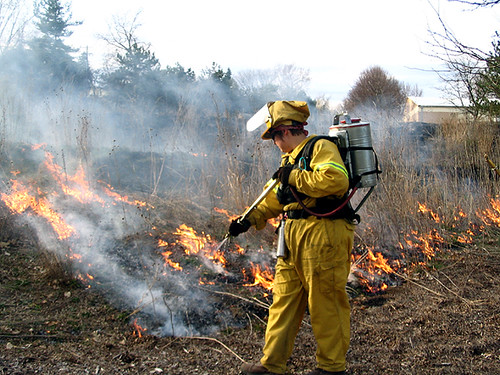 So there I was, driving home after meeting with a gardening client, minding my own business and all traffic laws, when suddenly, out of nowhere, I saw a welcome and familiar red sign: "Prescribed burn in process." Ooh! These controlled ecological burns are performed by Ann Arbor's Natural Area Preservation (NAP) — the same nice folks for whom I volunteer on the frog and toad survey — each spring and fall in Ann Arbor parks and natural areas. I had my camera in the car, so I headed into Buhr Park where the burn was taking place.
So there I was, driving home after meeting with a gardening client, minding my own business and all traffic laws, when suddenly, out of nowhere, I saw a welcome and familiar red sign: "Prescribed burn in process." Ooh! These controlled ecological burns are performed by Ann Arbor's Natural Area Preservation (NAP) — the same nice folks for whom I volunteer on the frog and toad survey — each spring and fall in Ann Arbor parks and natural areas. I had my camera in the car, so I headed into Buhr Park where the burn was taking place.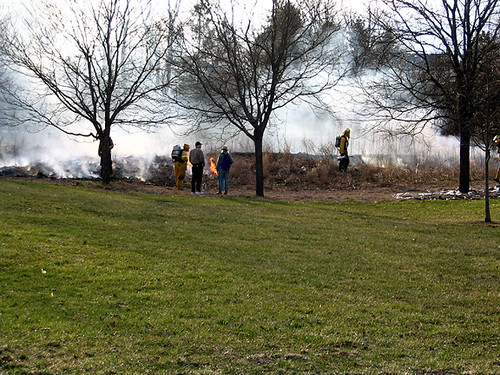 More precisely, the burn took place in the Buhr Park Children's Wet Meadow, right across from the playground and under a mile from where I live. (Um, wet in the sense that it's a rain garden, but in fact actually dry so it would have fuel to burn.) You can see it's a pretty contained area, being one large garden bed of native plants. Apparently, participants scattered native plant seeds on the site after the burn, but I left before that, although I did see Jeannine Palms, meadow steward, with seeds in hand.
More precisely, the burn took place in the Buhr Park Children's Wet Meadow, right across from the playground and under a mile from where I live. (Um, wet in the sense that it's a rain garden, but in fact actually dry so it would have fuel to burn.) You can see it's a pretty contained area, being one large garden bed of native plants. Apparently, participants scattered native plant seeds on the site after the burn, but I left before that, although I did see Jeannine Palms, meadow steward, with seeds in hand.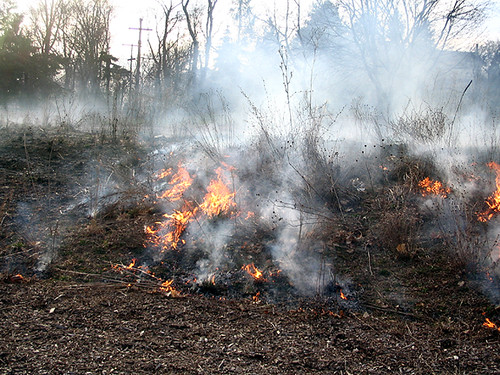 Michigan ecosystems (oak-hickory forests, prairies, grasslands) have depended on fires for hundreds of years. Fires were started naturally by lightning strikes and as controlled burns by native Americans. After settlers arrived, burning stopped. Over time, though, the lack of fire disrupted the natural balance, allowing non-native plants (which would have been kept in check with fire) to outcompete the native plant species (which would have continued to thrive with fire).
Michigan ecosystems (oak-hickory forests, prairies, grasslands) have depended on fires for hundreds of years. Fires were started naturally by lightning strikes and as controlled burns by native Americans. After settlers arrived, burning stopped. Over time, though, the lack of fire disrupted the natural balance, allowing non-native plants (which would have been kept in check with fire) to outcompete the native plant species (which would have continued to thrive with fire).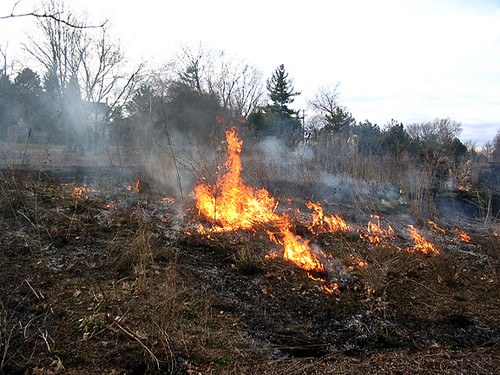 These controlled burns reintroduce fire to enrich the soil and to remove dead thatch and non-native invasive plants. They allow native plants, which are adapted to fire but have been suppressed by invasives, to again thrive. Native plants also attract native wildlife. The flames never got higher than this photo shows, and as you can see from the first photo, the burn crew has plenty of water on hand (or, on back!). The crew is well-trained, experienced, and always in control. We are not talking forest fires!
These controlled burns reintroduce fire to enrich the soil and to remove dead thatch and non-native invasive plants. They allow native plants, which are adapted to fire but have been suppressed by invasives, to again thrive. Native plants also attract native wildlife. The flames never got higher than this photo shows, and as you can see from the first photo, the burn crew has plenty of water on hand (or, on back!). The crew is well-trained, experienced, and always in control. We are not talking forest fires!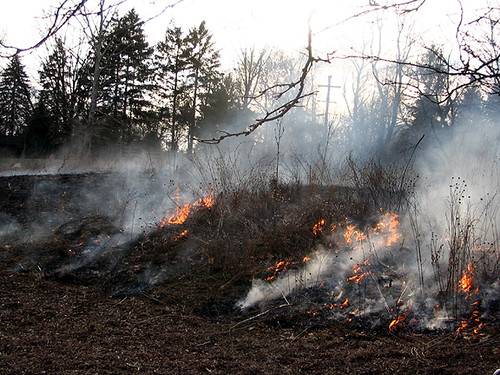 For more information on the benefits of prescribed burns, especially as relating to native plants, read my friend Aunita Erskine's editorial in the Ann Arbor News.
For more information on the benefits of prescribed burns, especially as relating to native plants, read my friend Aunita Erskine's editorial in the Ann Arbor News.For more burn photos and videos, check out this entry on NAP's blog.
About the post title, I'm thinking of the Tom Jones version of Ring of Fire, not because the original Johnny Cash version isn't good, or even better, but because I might just have the tiniest bit of a jones for Mr Jones. Hypothetically. Ahem.

Very interesting (and informative) post Monica. You explained the process and the reasoning behind it in terms that show how helpful the process is to the environment. I haven't heard of this happening around here, but as you said, it's a practice that your area has come to depend on for many decades. It sounds great for the environment.
ReplyDeleteVery interesting! We didn't know of the importance of this practice!
ReplyDeleteI've always wanted to see the burning process in person; thanks for the info on this fascinating procedure.
ReplyDeleteVery interesting! So glad you stopped and snapped photos. I find ashes are good for a lot of plants, including grasses. In NC where I used to live they burned their lawns every year-centipede grass. Folks here don't usually do it but do do prescribed burns sometimes.
ReplyDeleteOur conservationists do burns here every year. Oddly a lot of people turn out to watch the burns, I was surprised how many.
ReplyDeleteMarnie
I haven't seen first hand any controlled burns here in TN but they must happen....I love the beauty here but sometimes they are so behind ecologically! gail
ReplyDeleteWhile I'm glad that controlled burns are done at the prairies around here, I always dread it, as they always seem to do it on a nice day & the smoke always makes me sick. Here, burning is done spring and fall, as there is fortunately so much land that has been restored to prairie that they can't get it all done in one season.
ReplyDeleteHi Monica....what a fabulous post.....I found that so interesting.....and your explanation was so detailed......
ReplyDeleteI love the fact that only native plants will regrow....if only more people would do what is right for the land......
I didn't realize that they did control burns in the US. I've read that in Australia the natural fires that occur help the wildflowers germinate. Interesting post today, thanks for sharing!
ReplyDeleteReally interesting. They burn the heather on the moors in parts of the UK too.
ReplyDeleteJan,
ReplyDeleteBecause people often think of fire as negative in the landscape (wildfires), I thought it was better to be overly wordy than not explain at all! :)
Cat,
Phoenix mentioned they burned heather on the moors in England--do you know if they do that on the Lüneburger Heide, too?
Tim,
If you like fire as much as I do, it was a bit disappointing not to see huge flames, though of course for safety and such, huge flames are not needed!
Tina,
Cool, I had no idea people burned their lawns. That's really interesting. Some people in Ann Arbor have native plant gardens and they do burn every few years, but they have to get a permit and as "liberal" as AA is, they can be quite persnickety about this...
Marnie,
Well, people dare fascinated with fire (I am, anyway!) and it's educational and out of the ordinary to see a burn. This one was small; some the the natural areas are much larger, and they do them in sections, with firebreaks and whatnot all set up.
Gail,
Ann Arbor prides itself on being green and so forward-thinking, but in many some ways that's not true. Many eco groups exist and that's cool but our roads aren't great for bicycling (though we end up on lists all the time about how great the city if for bicycling--I can tell you, it's not, unless you fancy being nearly killed on a daily basis). (But that's my own hot button. Sorry!)
MMD,
Here it's spring and fall, too. There has to be enough dry foliage to have something to burn, and obviously it can't be raining, plus winds have to be very low to avoid the smoke spreading too far.
Cheryl,
I don't think it's ANY native plant, just many that are native in the oak-hickory type forests we used to have here (oaks are fire dependent, for example), plus grasslands and prairie plants.
Peri,
Fire is just fascinating and if you have an ax to grind with buckthorn (which I do, literally and figuratively) you wish it burned MORE! ;-)
Phoenix,
That's so interesting about the English moors. I'm going to try to research that, as well as whether they do it on the moors in northern Germany.
~Monica
Very cool! We have a Nature Conservancy prairie (Sundrop Prairie not too far from here. I used to drive past it every day on my way back and forth from work. Those controlled burns became familiar spring sights!
ReplyDeleteIt definitely looks like it falls into the category of "Do not try this at home!"
This is a very interesting post as I didn't know anything about it other than I had heard of controlled burns. Thanks for this Monica...Michelle
ReplyDeleteHi Monica, I just saw a controlled burn in my area yesterday and nodded wisely. It does all the things you say and also gets rid of highly combustible brush that could get out of control quickly with a careless cigarette tossed from a car window. The drought we have been experiencing the last two years causes this to be a high priority of the fire departments. Get rid of the fuel.
ReplyDeleteFrances
I've been wanting to view a burn in forever. I love this practice although about 15 years ago when I was in college I took an environmental politics class and they were burning some of the woods in Chicago to get rid of buckthorn. The residents were so upset by the burn they had to put a moratorium on it and we got to go to city council meetings to watch the 2 sides battle. I've been for BURN ever since.
ReplyDeleteVery interesting! It makes sense that the native plants would do better if the landscape were burnt now and then. Looks a heck of a lot easier than pulling out invasives by hand! (More effective, too.)
ReplyDeleteThis comment has been removed by a blog administrator.
ReplyDeleteThis comment has been removed by a blog administrator.
ReplyDelete